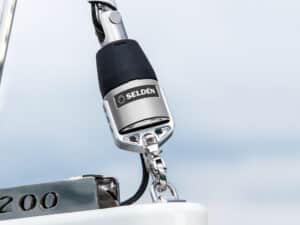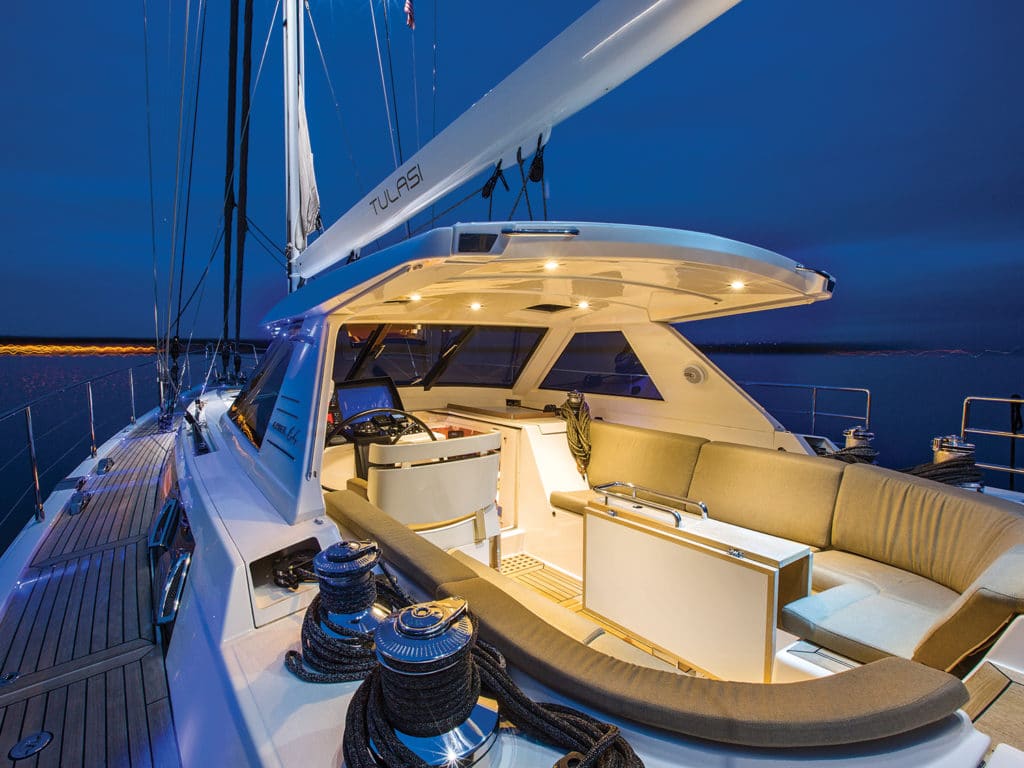
It’s time: Your engine barely turns over to start and your cabin lights are getting dimmer faster, both signs that you might have a shortage of available electrical power. That means you’ll either need to replace your existing batteries or figure out how to improve on your current power supply.
What are your options? A trip to the West Marine website is telling. Currently, it lists 56 different battery options. Of those, 17 are flooded-lead acid; 36 use absorbed glass mat (AGM) technology; there are seven gel-cell batteries; and three lithium choices that are proprietary and dedicated replacements for Torqeedo products. If you have any faith in market-driven inventory control, then the choice is clear: AGM is the way to go today. If the buyers at West Marine select twice as many AGM battery options as compared with traditional flooded cell devices, that speaks to me. Further, the only lithium choices West Marine currently offers are dedicated to a specific product that has always used high-quality lithium technology as its power source.
So let’s look at where we are with each of these technology choices and what you need to consider if you are thinking about shifting from one to another.
It’s a System
To really dig into this whole matter and get it right today requires thinking about batteries as part of an onboard system. This system includes the batteries, an alternator, voltage regulator, a shore-power-driven battery charger, maybe an onboard AC generator and, for the cruising sailor, water, wind and/or solar chargers. The system also includes both the AC and DC wiring needed to properly interconnect all the other equipment. The prudent sailor will probably want to add a battery-monitoring system as well to act as a fuel gauge for the electrical power supply.
Let’s begin this analysis by answering the question: What are we trying to achieve?
Value for your battery dollar is the most likely answer. Historically, I’ve always used cost-per-amp-hour of power as my guide. This is determined by knowing the average cycle life and using the battery’s amp-hour rating and either a 50 percent or 80 percent discharge, depending on the recommended levels of discharge per cycle. Next, multiply the amp hours by the number of cycles, and then divide the battery price by the number of amps derived earlier, and you’ll have a value for the cost per amp hour. The problem with this approach is that it relies heavily on battery-cycle life, which is controlled in large part by all the elements in the system that I described above.
When I wrote the first edition of my Power Boater’s Guide to Electricity back in 2000, the numbers looked like this:
- Flooded-cell lead-acid: 0.00065 cents per amp hour
- Gel cell: 0.0027 cents per amp hour
- AGM: 0.0013 cents per amp hour
Keep in mind that these figures were based on manufacturers’ estimated cycle life for their respective products, so there may have been some “optimism” in their advertised cycle-life expectations. Also, because we really didn’t know any better at the time, I assumed an average 50 percent discharge level for each cycle for all three technologies; deeper discharge levels hadn’t been recommended.
Today’s numbers look a bit different because they take into account current pricing and 80 percent discharge levels for both gel-cell and AGM technologies. Here’s how today’s cost-per-amp-hour values add up:
- Flooded-cell lead acid: 0.015 cents per amp hour
- Gel cell: 0.010 cents per amp hour
- AGM: 0.016 cents per amp hour
Clearly, prices have changed for all three types of batteries, but it appears that large disparities between them have been reduced considerably. (Cycle-life data for this analysis came from both West Marine and civicsolar.com.) Add to these prices the cost of the equipment needed to properly charge these batteries to ensure maximum cycle life, and I think you’ll find a significant jump in the gel-cell cost per amp hour. Read on, and I’ll explain.
Gel-Cell Potential
Battery technology has improved considerably in the past 20 years, in part because of the interest in electric cars and trucks, so a change in the cost-per-amp-hour numbers is to be expected. Even back when I originally looked at them, I remember talking with the folks at East Penn manufacturing, makers of the popular Deka brand of marine batteries. They told me their warranty data indicated that their gel-cell line of batteries would outcycle flooded-cell or AGM technology in deep-cycle applications. Their position remains the same today.
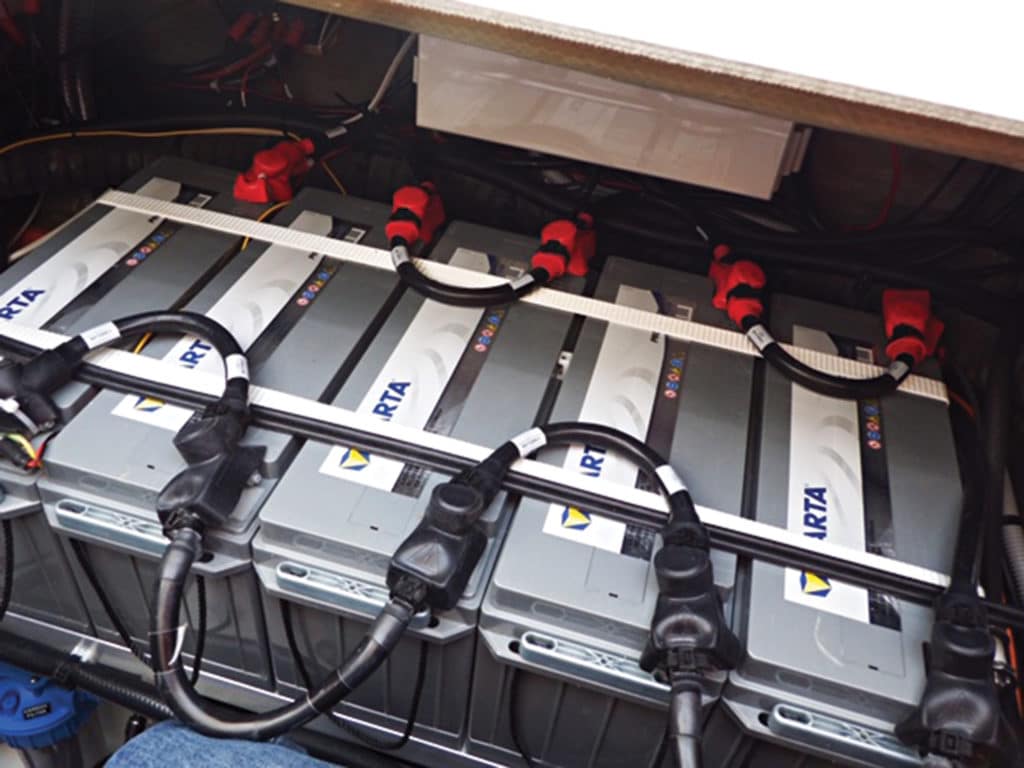
But there’s more to consider than just the number of cycles. Because of their construction, gel-cell batteries are the most finicky about their recharge regimen, and in my own experience, improper charging is what kills them—and it can happen rather quickly, typically in one sailing season or less. So, if you want to go the gel-cell route, be prepared to upgrade your engine’s alternator to one with a remote, programmable voltage regulator. Also, make sure that your shore-power charger, if you have one, has a gel-cell setting or adjustable voltage levels for its various phases of charging. Any solar- or wind-charging units must be run through a charge controller that can handle the lower voltages required by the gel batteries.
Here’s why: Depending on the manufacturer requirements, gel batteries should never be subjected to a recharge voltage greater than 14.7 volts, and some vendors state no more than 14.1 volts for any sustained period. Therein lies the problem: Internal voltage regulators on engine-driven alternators are of the constant-rate variety and typically produce in excess of 15 volts. So, in a nutshell, whenever your engine is running, you are rapidly destroying a gel-cell battery unless a programmable regulator has been installed in the system and set appropriately.
Now, don’t get me wrong—gel-cell batteries have some real advantages. They are sealed-valve-regulated, meaning they will vent, but only under overcharging if excess pressure builds up. They require essentially zero maintenance, and have excellent deep-cycling capability and a very low self-discharge rate (3 percent per month). But again, they must be connected to a properly calibrated charging source. If your boat is already equipped with gear that can be adjusted to meet the need, this could be a great choice. Otherwise, some detailed cost analysis is needed, and you might find that your cost-per-amp-hour is too high after all the upgrades are factored in.
A Look at AGM
AGM batteries have come a long way over the past two decades as well. Spiral cells and thin plate pure lead (TPPL) are two of several examples of how battery-makers have worked to optimize the amount of power they can squeeze into a battery of a given size. Like their gel-cell brothers, AGM batteries are sealed-valve-regulated, low maintenance, and can be discharged to extreme levels—80 percent of their capacity versus 50 percent for conventional flooded-cell batteries. AGMs also have a significantly higher recharge acceptance rate—35 to 45 percent of capacity in amperes versus 25 to 30 percent for traditional flooded-cell batteries. And they have a very low self-discharge rate, similar to gel cells.
Unfortunately, like their flooded brethren, AGM batteries are prone to sulfation when left in a partially charged state for extended periods of time. Sulfation is a natural occurrence that over time will coast the cell plates with nonconductive lead-sulfate crystals. This effectively reduces the plate’s exposed surface area to electrolytes in the cell, and in turn reduces the capacity of the battery, ultimately rendering it useless.
This is a common cruising-boat issue that a conscientious captain can easily overcome with a little bit of diligence. The fix here is to make sure these batteries frequently get a full charge.
The good news is that unlike gel cells, AGM batteries can take regular and higher ampere and voltage amounts when recharging, with minimal fear of damage. In fact, one potential problem is that the alternator will be working so hard, it might overheat and be damaged. In the case of a shore-power-supplied charger, just make sure its capacity rating is adequate so it’s not running at 100 percent output constantly. If the charger was marginal when used with flooded-cell batteries, replacing old batteries with AGM technology could force the need for a new charger, again skewing that cost-per-amp-hour number.
Another thing to consider, if you’re replacing traditional batteries with AGMs, is their size and shape. Because of the way in which these batteries are made, they do not necessarily conform to traditional Battery Council International group sizes. Understand that the internal components for these batteries are compressed to maximize the amount of plate contact area with the glass-mat medium before being dropped into the outer case. The advantage here is that these batteries will typically have higher current densities, meaning more power for a given physical dimension; the disadvantage, however, might be the way that space for batteries was engineered into your boat. You might find that the battery storage area is going to need extensive modification to fit your new-age powerhouses. That’s another factor that could skew the cost-per-amp-hour calculation.
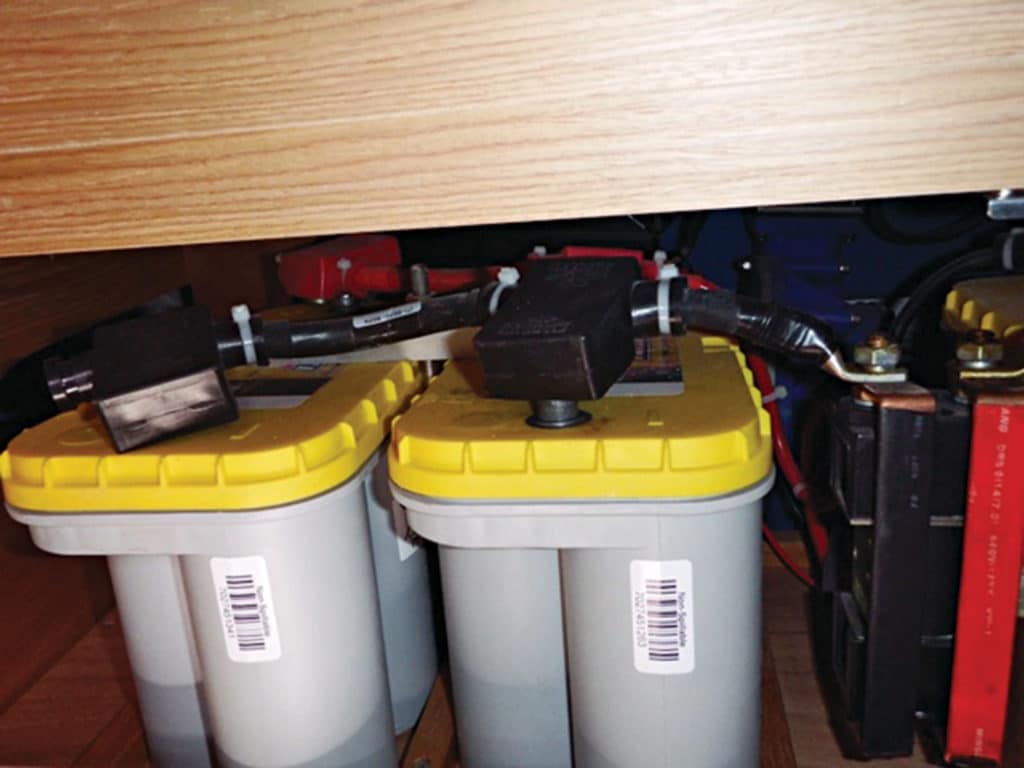
The advantages to both AGM and gel-cell batteries include their mechanical prowess. The pressing together and inherent rigidity of the gel in the gel-cell case creates batteries that can withstand vibration and rough-sea pounding much better than their flooded-cell counterparts. Mechanical failure of batteries is not that uncommon.
Ready for Lithium?
Over the past decade, the buzz in the world of batteries has centered on lithium technology. Here we have all the advantages of AGM technology, plus an opportunity to have even more current density coupled with an exponential reduction in weight.
What’s not to love?
Well, unless you’ve been living under a rock, you’ve also heard about boats using lithium batteries that have burned to the waterline. There are a lot of factors to understand here, which is why you need to think about a battery installation in a system context, and also consider the technology itself.
At least some of the fires caused by lithium batteries were due to the actual chemistry used. But there have also been issues with how they were manufactured (cleanliness when making the individual cells is imperative) and with the design—or lack of it—when it comes to battery management systems, or BMS as they’re called in the trade.
Today, virtually all the vendors I’m familiar with are using lithium-iron-phosphate or lithium-nickel-manganese-cobalt-oxide chemistries, both of which have good track records.
It’s important to understand that if a lithium battery does catch fire, conventional fire-extinguishing systems will not put out the blaze. Once the electrolyte catches fire (regardless of actual chemistry, all of the electrolytes are flammable), the only way to extinguish it is to cool it with water—lots of water! That said, the reputable manufacturers seem to have figured out all of this and do absolutely everything possible to ensure that a fire is extremely unlikely.
To keep things in context, consider this: Liquefied petroleum gas is extremely flammable and explosive, yet we use it aboard cruising boats quite regularly. If recognized standards for installation and maintenance are followed, any inherent danger is minimized to the point where we hardly give it a thought. The same thing needs to happen with lithium-battery technology. The American Boat and Yacht Council is working on developing a technical information report covering lithium-battery installations, and it is in draft form and being reviewed as I write this. Hopefully we can get a published document in place in 2020.
But I digress—back to the systems approach, which I can’t emphasize enough. If you are the technical type and determined to have the latest and greatest technology on your cruising boat, be prepared to spend some real money on all the elements required for the system to operate safely.
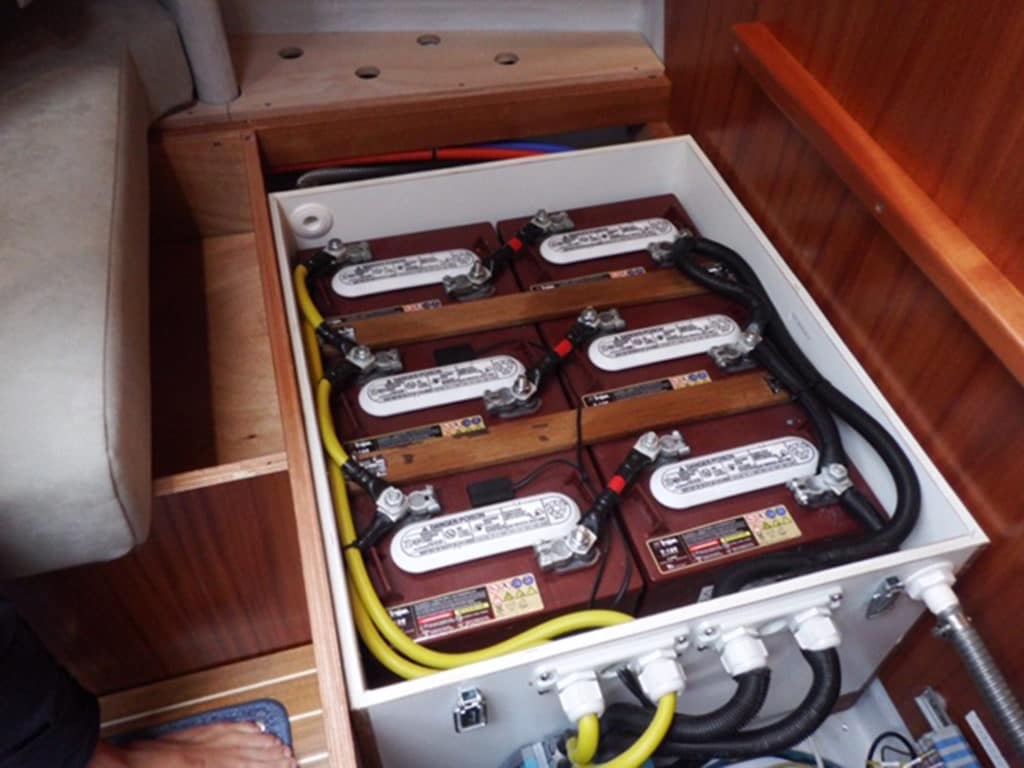
First, you will have trouble with your engine alternator running too hot as it works hard to keep up with the charging needs of these batteries. It makes sense to install a thermal sensor that shuts down the alternator if it gets too hot. Balmar offers this option with its alternator/programmable-voltage-regulator combination.
Next, make sure your shore-powered battery charger has appropriate settings for lithium batteries. Then provide as much cooling as possible to the alternator; I’ve seen electric blower fans employed for this purpose.
Then, be sure you understand how the BMS on your boat functions. You might discover that the BMS is engineered to electrically shut down the battery/batteries if it senses a problem. Well, if the engine is running, this sudden shutdown could cause a voltage spike in your DC-electrical system, possibly damaging expensive and mission-critical electronics. Yanmar recommends installing a conventional battery as a system backup in case this happens. That’s yet another expense and one more thing to worry about.
On the plus side with either lithium or AGM technology, with careful planning and load analysis, the recharge absorption rate is so high that you might just be able to eliminate that AC generator to recharge batteries when offshore. Add some solar- and wind-generated power, and engine run time with the alternator can be reduced dramatically.
Bottom Line on Batteries
I’m of the opinion that we are at an interim phase in technological development when it comes to batteries and the systems that surround them. We are seeing cities around the world that are mandating no fossil-fueled vehicles within city limits. Initiatives like this will force the play toward more and more electric vehicles. With that comes engineering investment that will pay off in the form of better batteries, enhanced safety protocols and trickle-down technology useful to the marine sector.
For now, though, I’m going to follow the suggested directive from the West Marine buyers’ group and go with AGM technology. An AGM TPPL battery is mechanically rugged, requires minimal maintenance, will probably work with my existing battery charger and alternator combination. Better yet, they can be heavily discharged and and recharged quite rapidly. That’s good enough for me.
Ed Sherman is vice president of education at the American Boat and Yacht Council, and is a frequent CW contributor on technical issues, as well as a longtime Boat of the Year judge.




